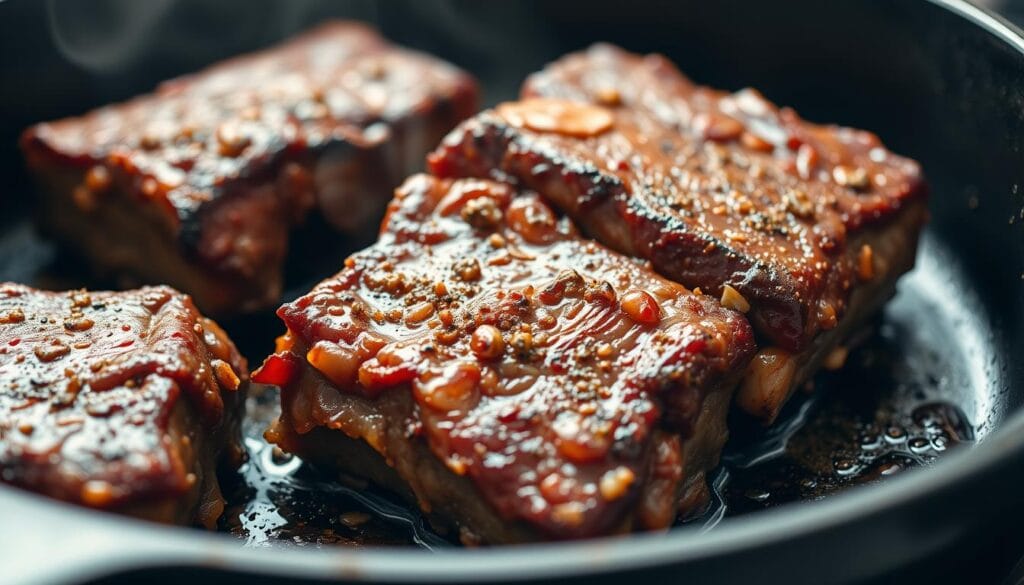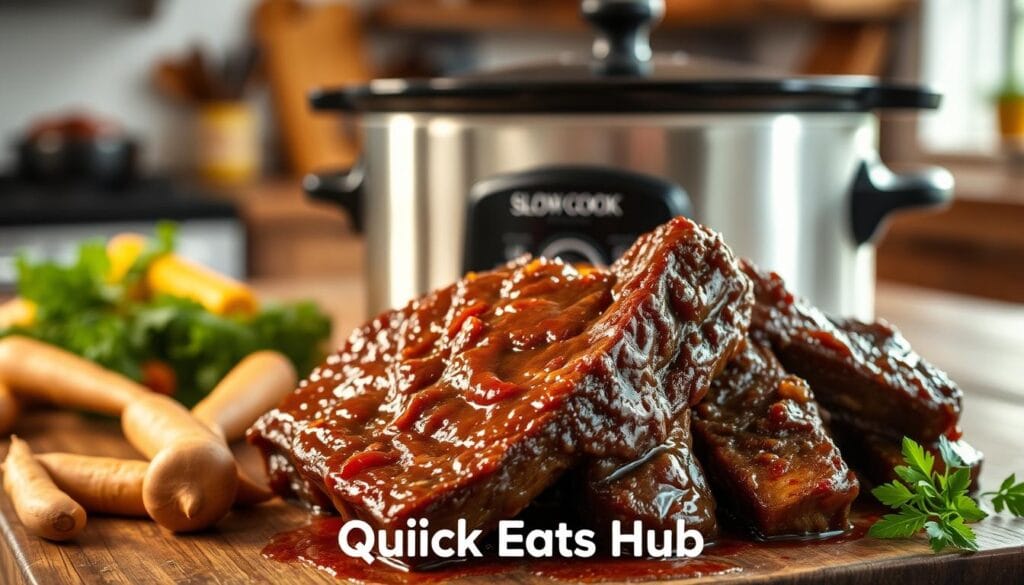Imagine coming home to a hearty, flavorful meal with minimal effort. Slow-cooked beef short ribs offer a delicious solution for a family-friendly dinner. This recipe is designed to be simple, avoiding complicated ingredients like wine, making it accessible for everyone.
The appeal of slow-cooked meat lies in its tender texture and rich flavor, achieved effortlessly with a slow cooker. By following practical tips and searing techniques, you can create a dish that’s both satisfying and easy to prepare.
This guide provides a comprehensive, step-by-step approach, ensuring a perfect meal every time. The result is hearty, with rich gravy and melt-in-your-mouth meat, backed by trusted sources for reliability.
Table of Contents
Introduction to Slow Cooker Short Ribs
Discover the magic of transforming tough cuts of beef into a mouthwatering meal with minimal effort. Slow cooker short ribs are a perfect example of how low-and-slow cooking can elevate a humble cut of meat into a gourmet dish.
Why Slow Cooking is Ideal for Short Ribs
The slow cooker is a game-changer for tougher cuts like short ribs. The extended cooking time breaks down the connective tissue, turning it into a rich, gelatinous texture that enhances the dish’s flavor and tenderness. This process ensures that the meat becomes fork-tender, practically falling off the bone.
One of the biggest advantages of slow cooking is the depth of flavor it achieves. As the ribs simmer in a mixture of spices, tomato paste, and garlic, the flavors meld together, creating a savory sauce. This method is not just about convenience; it’s about crafting a meal that’s both comforting and impressive.
“The slow cooker is a chef’s best friend when it comes to short ribs. It transforms a tough cut into something truly special.”
| Benefit | Detail |
|---|---|
| Tender Texture | Connective tissue breaks down into gelatin |
| Flavor Depth | Rich sauce from slow-cooked ingredients |
| Convenience | Perfect for family dinners or special occasions |
Without using wine, this recipe focuses on the natural flavors of the beef and spices, making it accessible to everyone. By the end of this guide, you’ll understand why slow cooking is the perfect method for creating a hearty, comforting meal.
Essential Ingredients and Preparation Essentials
Creating a mouthwatering meal starts with the right ingredients. For the best results, focus on fresh, high-quality components that enhance natural flavors without unnecessary additives.
Selecting the Best Beef Short Ribs
Choose meaty, well-marbled short ribs for optimal flavor and texture. These cuts ensure ample beef for a hearty family meal. Look for ribs with a good balance of fat, as it enhances tenderness and flavor during slow cooking.
Prepping Vegetables and Herbs for Maximum Flavor
Fresh vegetables like onions, carrots, and celery add depth to your dish. Mince garlic for robust seasoning. Fresh herbs such as thyme and rosemary provide aromatic flavors without needing alcohol. Trim excess fat from the ribs, leaving enough to infuse richness into the sauce. Season generously with salt and pepper for a solid flavor foundation.
| Ingredient | Role |
|---|---|
| Beef Short Ribs | Provides the main protein and texture |
| Garlic | Enhances flavor profile |
| Salt and Pepper | Seasoning for depth |
| Tomato Paste | Rich, savory base for sauce |
Thoughtful ingredient selection is key to a memorable meal. By focusing on quality and proper preparation, you’ll achieve a dish that’s both satisfying and flavorful.
Step-by-Step Cooking Process
Transforming beef short ribs into a tender, flavorful dish is easier than you think. Follow these simple steps to achieve perfection in your slow cooker.
Searing and Browning the Meat
Start by heating a skillet over medium-high heat. Sear the beef short ribs for about 5 minutes on each side to create a caramelized crust. This step is crucial for locking in flavors and developing a rich texture. The Maillard reaction during searing enhances the dish’s overall flavor profile.
Setting Up Your Slow Cooker
After searing, transfer the ribs to the slow cooker. Add your choice of vegetables, garlic, and spices. Pour in tomato paste mixed with enough liquid to almost cover the ribs. Set the slow cooker to low heat for 6-8 hours or high heat for 4-5 hours.
| Step | Action |
|---|---|
| 1 | Sear ribs in a hot skillet for 5 minutes per side. |
| 2 | Transfer ribs to the slow cooker. |
| 3 | Add vegetables, garlic, and spices. |
| 4 | Mix tomato paste with liquid and pour over. |
| 5 | Cook on low for 6-8 hours or high for 4-5 hours. |
Let the slow cooker do the work while you attend to other tasks. This hands-off approach ensures tender, fall-off-the-bone meat with a rich, savory sauce. Perfect for a hassle-free, delicious meal.
Techniques for Searing Short Ribs
Mastering the art of searing is the first step to creating a truly exceptional dish. This process is crucial for developing the rich, caramelized crust that elevates your short ribs to the next level.
The Role of Searing in Enhancing Flavor
Searing is more than just browning the meat; it’s about chemistry. The Maillard reaction, a chemical reaction between amino acids and reducing sugars, occurs when food is cooked, leading to new flavor compounds. This reaction is what gives seared meat its deep, savory flavor and appealing aroma.
To achieve the perfect sear, heat your skillet over medium-high heat. Add a small amount of oil to the pan and let it shimmer before adding the ribs. Sear each side for about 45 seconds, just until a golden-brown crust forms. Avoid stirring too much, as this can disrupt the formation of the crust.

Proper searing also helps render excess fat, making the meat more tender. Look for visual cues like a deep brown color and a crispy texture. Once seared, transfer the ribs to your slow cooker, leaving the drippings in the skillet for added flavor.
For the best results, sear all sides evenly and avoid overcrowding the pan. If your slow cooker has a sear function, use it for convenience. Otherwise, a skillet works perfectly. After searing, let the slow cooker take over, simmering the ribs in your prepared sauce on low for 6-8 hours or high for 4-5 hours.
Locking in natural juices during searing ensures tender, flavorful meat. This step sets the stage for a delicious, hassle-free meal. For more tips on seasoning, visit our guide on beef short rib seasoning.
Creating a Delicious Gravy
After hours of slow cooking, the flavorful liquid in your slow cooker is packed with rich, savory goodness. This liquid is the foundation for a mouthwatering gravy that complements your tender short ribs perfectly. To create this delicious gravy, follow these simple steps:
Preparing the Rich Cooking Liquid
Start by skimming off any excess fat from the surface of the cooking liquid. This step ensures a cleaner-tasting gravy. Next, transfer the liquid to a saucepan and bring it to a boil. Reduce the heat to a simmer and let it cook for about 10-15 minutes to concentrate the flavors.
Thickening Techniques with Cornstarch
To thicken the gravy, mix 1 tablespoon of cornstarch with 2 tablespoons of cold water until smooth. Stir this slurry into the simmering liquid and continue cooking for another 5 minutes, or until the gravy reaches your desired consistency. You can adjust the thickness by adding more cornstarch slurry or a little water.
| Step | Action |
|---|---|
| 1 | Skim excess fat from the cooking liquid. |
| 2 | Simmer the liquid to reduce and concentrate flavors. |
| 3 | Prepare cornstarch slurry with cold water. |
| 4 | Add slurry to the liquid and cook until thickened. |
The result is a rich, velvety gravy that enhances the flavor of your slow-cooked beef short ribs. Serve it over mashed potatoes or your favorite side dish for a truly satisfying meal.
Alternative Methods for Tender Short Ribs
While slow cookers are ideal for tenderizing short ribs, there are alternative methods to achieve similarly delicious results. These techniques are perfect for when you don’t have access to a slow cooker or prefer a different cooking approach.
Oven Braising Option
Oven braising is a reliable alternative that delivers tender meat and rich flavors. Preheat your oven to 275°F (140°C). Brown the short ribs in a skillet, then transfer them to a Dutch oven or heavy roasting pan. Add your chosen aromatics and liquid, ensuring the ribs are mostly submerged. Cover the dish and braise for 3-4 hours, checking periodically to maintain liquid levels. This method ensures even cooking and a fall-off-the-bone texture.
Pressure Cooker Adaptation
For a quicker option, adapt your recipe for a pressure cooker. Brown the ribs first, then add aromatics and liquid. Cook on high pressure for 45-60 minutes, followed by a 15-minute natural release. This method significantly reduces cooking time while retaining tenderness and flavor.
- Oven braising offers precise temperature control for consistent results.
- Pressure cooking is ideal for those short on time, cutting hours off the cooking process.
Both methods maintain the integrity of the beef without needing wine or pork, ensuring a rich, satisfying meal. Troubleshooting tips include checking liquid levels in the oven and adjusting pressure cooker times for larger batches. These alternatives are perfect for maintaining the recipe’s flavor profile without a slow cooker.
Explore these methods to enjoy tender, flavorful short ribs no matter your cooking setup. Each technique ensures a delicious meal with minimal effort, catering to different preferences and time constraints.
Expert Tips for Enhancing the Recipe
Elevate your short rib dish with expert advice that focuses on natural flavors and smart techniques. These tips will help you create a memorable meal without adding alcohol.
Boosting Flavor Without Additional Alcohol
Enhance your dish with these expert tips:
- Use robust seasonings like garlic, salt, and pepper for depth.
- Add a tablespoon of balsamic vinegar for a tangy twist.
- Maximize caramelization during searing for a richer flavor.
| Technique | Benefit |
|---|---|
| Proper Seasoning | Enhances natural beef flavor. |
| Caramelization | Develops a rich, savory crust. |
| Balsamic Vinegar | Adds a tangy, fruity note. |
For more seasoning ideas, visit our guide on beef short rib seasoning.
cooking short ribs in a slow cooker
Discover how a slow cooker can transform tough beef cuts into a mouthwatering meal with minimal effort. This method ensures tender, flavorful results every time.
The slow cooker’s extended cooking time breaks down connective tissue, turning it into a rich, gelatinous texture that enhances the dish’s flavor and tenderness. This process ensures that the meat becomes fork-tender, practically falling off the bone.
One of the biggest advantages of slow cooking is the depth of flavor it achieves. As the ribs simmer in a mixture of spices, tomato paste, and garlic, the flavors meld together, creating a savory sauce. This method is not just about convenience; it’s about crafting a meal that’s both comforting and impressive.
Without using wine, this recipe focuses on the natural flavors of the beef and spices, making it accessible to everyone. By the end of this guide, you’ll understand why slow cooking is the perfect method for creating a hearty, comforting meal.

The slow cooker is a game-changer for tougher cuts like short ribs. The extended cooking time breaks down the connective tissue, turning it into a rich, gelatinous texture that enhances the dish’s flavor and tenderness. This process ensures that the meat becomes fork-tender, practically falling off the bone.
One of the biggest advantages of slow cooking is the depth of flavor it achieves. As the ribs simmer in a mixture of spices, tomato paste, and garlic, the flavors meld together, creating a savory sauce. This method is not just about convenience; it’s about crafting a meal that’s both comforting and impressive.
Without using wine, this recipe focuses on the natural flavors of the beef and spices, making it accessible to everyone. By the end of this guide, you’ll understand why slow cooking is the perfect method for creating a hearty, comforting meal.
Storing, Reheating, and Leftover Ideas
Properly storing and reheating your slow-cooked beef short ribs ensures they remain flavorful and tender. Follow these tips to enjoy your meal even after the initial serving.
Refrigeration and Freezing Tips
Cool the ribs slightly before refrigeration to prevent moisture loss. Place them in an airtight container with some sauce, refrigerate for up to four days, and freeze for up to three months.
| Storage Method | Duration | Tips |
|---|---|---|
| Refrigeration | 3-4 days | Store in airtight container with sauce. |
| Freezing | Up to 3 months | Use freezer-safe containers; press out air before sealing. |
For reheating, use low heat on the stovetop or warm in the oven at 300°F, adding reserved cooking liquid to maintain moisture. Avoid boiling to prevent drying out the meat.
“The key to reheating is to do it gently, allowing the meat to warm through without losing its tender texture.”
Consider using leftovers in creative ways, such as in sandwiches or as a topping for salads. Planning ahead, you can enjoy your delicious short ribs for several meals without compromising on flavor or texture.
Conclusion
With this comprehensive guide, you now have all the tools to create a mouthwatering, tender beef short rib dish using your slow cooker. The process is simple yet effective, ensuring a flavor-packed meal with minimal effort. By following the steps from selecting the best ingredients to properly storing leftovers, you can enjoy a hearty meal that impresses every time.
The key to success lies in the combination of careful preparation and the slow cooking process. Techniques like searing and simmering enhance the dish’s flavor, while the slow cooker does the hard work for you. This method respects your preferences by omitting wine and pork, focusing instead on natural flavors and smart techniques.
Feel confident in trying this recipe at home, knowing it’s backed by trusted sources and expert tips. For the best results, remember to sear the ribs properly, use high-quality ingredients, and let the slow cooker handle the rest. Your patience will be rewarded with a delicious, comforting meal that your family and friends will love.
If you have any feedback or tips from your experience with this recipe, we’d love to hear them. Don’t forget to share this guide with others who might enjoy it and explore more cooking guides for future meals. Thank you for following this detailed guide, and happy cooking!


1 thought on “Easy way for cooking short ribs in a slow cooker”